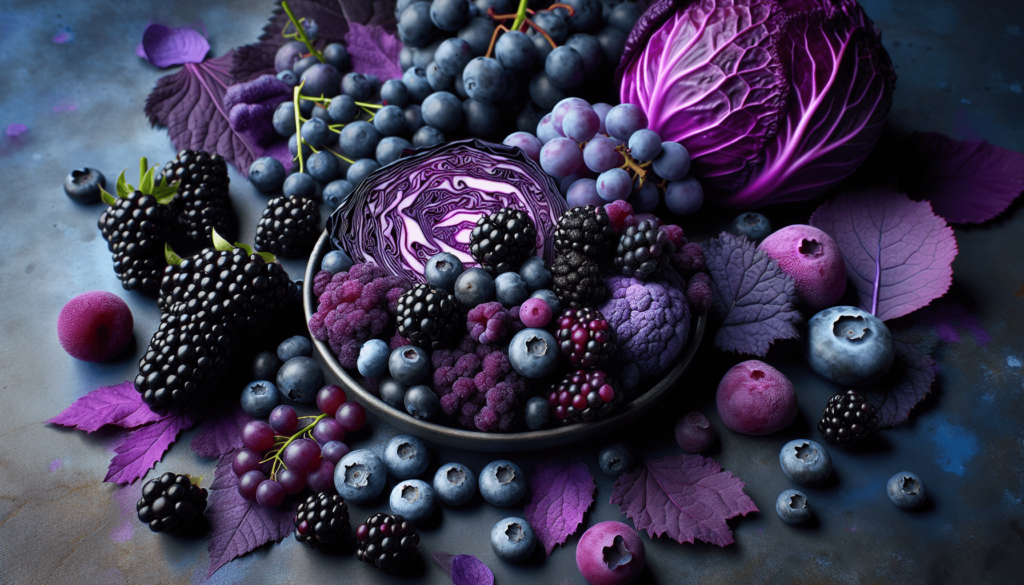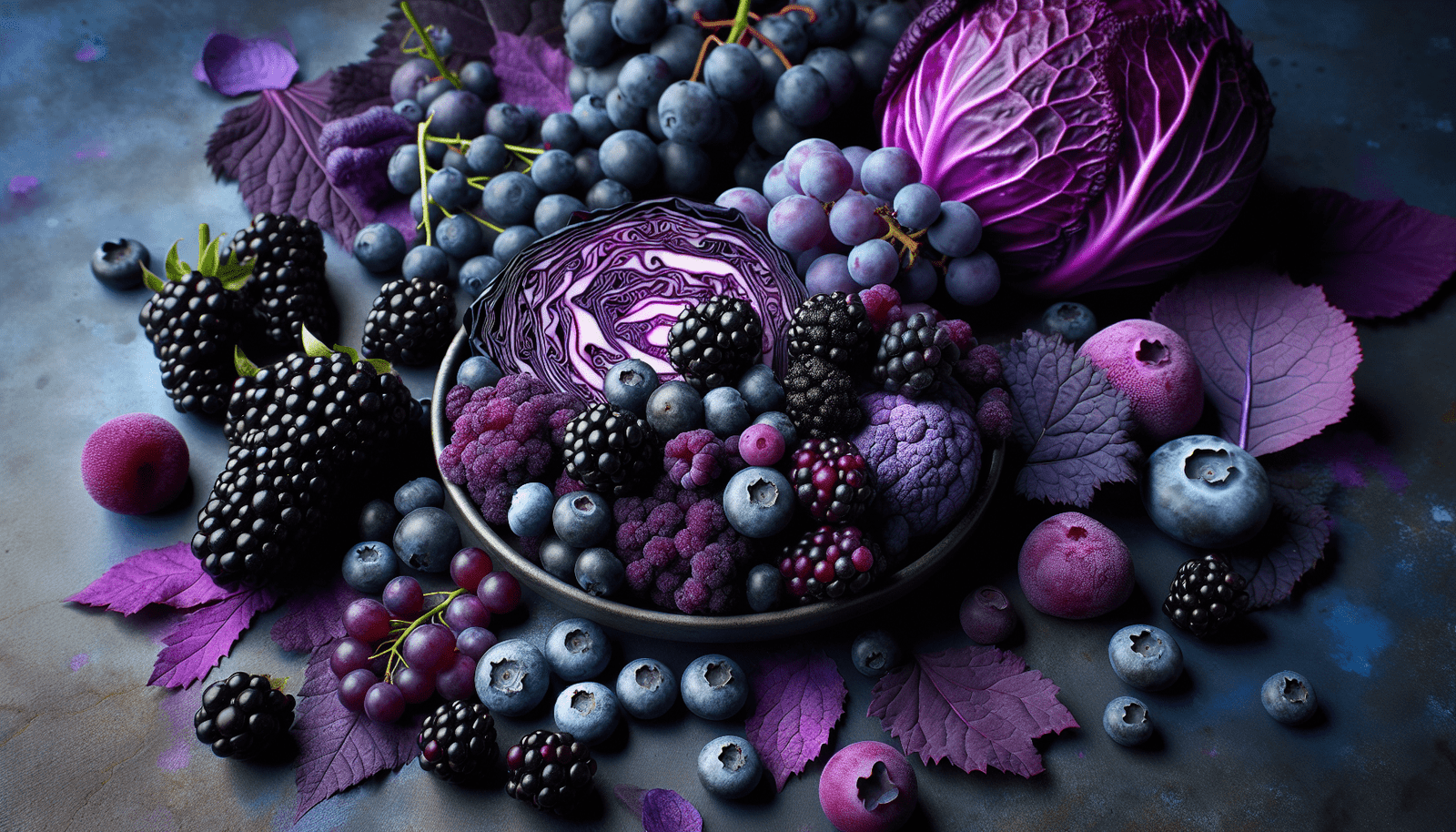Have you ever wondered why purple foods are so powerful?
Purple foods, such as blueberries, blackberries, purple potatoes, and eggplants, have gained popularity in recent years due to their health benefits. The secret behind their vibrant color and nutritional value lies in a group of compounds called anthocyanins. In this article, we will delve into the power of purple foods and explain the science behind anthocyanins.

Understanding Anthocyanins
Let’s break it down for you – anthocyanins are a type of flavonoid compound that give purple, blue, and red hues to fruits, vegetables, and flowers. These pigments not only make these foods visually appealing but also provide a range of health benefits. Anthocyanins are powerful antioxidants that help protect our cells from damage caused by free radicals.
Antioxidant Properties of Anthocyanins
Imagine anthocyanins as your body’s shield against harmful free radicals. These compounds neutralize oxidative stress in the body, which can lead to chronic diseases like cancer, heart disease, and diabetes. By incorporating purple foods rich in anthocyanins into your diet, you are giving your body a natural defense system to combat oxidative damage.
Anti-Inflammatory Effects of Anthocyanins
Inflammation is a natural response by the body to injury or infection, but chronic inflammation can contribute to various health problems. Anthocyanins have been shown to possess anti-inflammatory properties, helping to reduce inflammation and alleviate symptoms of conditions like arthritis and inflammatory bowel disease. By including purple foods in your meals, you can help support a healthy inflammatory response in your body.
Health Benefits of Purple Foods
Now that you understand the science behind anthocyanins, let’s explore the specific health benefits of incorporating purple foods into your diet. From improved cardiovascular health to enhanced cognitive function, purple foods offer a wide range of advantages for your overall well-being.
Cardiovascular Health
Purple foods have been linked to improved cardiovascular health due to their ability to reduce blood pressure, lower cholesterol levels, and prevent arterial plaque buildup. These heart-healthy benefits can help lower your risk of heart disease and stroke. Including purple fruits like grapes and berries in your diet can support a healthy heart and circulation.
Brain Function
Anthocyanins have been shown to have neuroprotective effects, helping to support brain health and cognitive function. Purple foods may enhance memory, concentration, and overall brain performance. Consuming foods rich in anthocyanins, such as blackberries and purple sweet potatoes, can help boost your brainpower and protect against age-related cognitive decline.
Weight Management
If you’re looking to maintain a healthy weight or shed a few pounds, purple foods can be a valuable addition to your diet. Anthocyanins have been found to support metabolism, regulate blood sugar levels, and promote satiety. By including purple vegetables like purple cabbage and eggplants in your meals, you can aid in weight management and feel satisfied longer.
Skin Health
The antioxidant properties of anthocyanins can benefit your skin by protecting it from environmental damage and signs of aging. Purple foods help maintain skin elasticity, promote collagen production, and reduce the appearance of wrinkles. Adding purple fruits like plums and figs to your diet can contribute to healthy, glowing skin from the inside out.
Eye Health
Anthocyanins play a vital role in supporting eye health and reducing the risk of age-related vision problems. Purple foods like blueberries and black currants contain these vision-protecting compounds, which help prevent macular degeneration and cataracts. Including these foods in your diet can promote clear vision and maintain eye health as you age.
Incorporating Purple Foods Into Your Diet
Now that you’re aware of the numerous health benefits of purple foods, it’s time to learn how to incorporate them into your daily meals. Whether you’re a fan of fruits, vegetables, or grains, there are plenty of delicious options to choose from that will provide you with a dose of anthocyanins.
Fruits
Fruits are a convenient and tasty way to add purple foods to your diet. Berries like blueberries, blackberries, and raspberries are rich in anthocyanins and can be enjoyed fresh, frozen, or in smoothies. You can also snack on purple grapes, plums, or figs for a sweet and nutritious treat.
| Purple Fruits | Anthocyanin Content (mg/100g) |
|---|---|
| Blueberries | 163 |
| Blackberries | 149 |
| Grapes | 101 |
| Plums | 73 |
Vegetables
Vegetables offer a variety of options to incorporate purple foods into your meals. Eggplants, purple cabbage, and purple sweet potatoes are excellent choices that can be roasted, grilled, or sautéed. You can also try purple asparagus, carrots, or cauliflower for a colorful and nutrient-rich addition to your plate.
| Purple Vegetables | Anthocyanin Content (mg/100g) |
|---|---|
| Eggplants | 750 |
| Purple Cabbage | 45 |
| Purple Sweet Potatoes | 35 |
| Purple Asparagus | 18 |
Grains
Whole grains like purple cornmeal, black rice, and purple barley offer a unique way to include purple foods in your diet. These grains can be used in salads, side dishes, or main courses to add color, flavor, and nutrients to your meals. You can experiment with different recipes to incorporate these purple grains into your cooking.
| Purple Grains | Anthocyanin Content (mg/100g) |
|---|---|
| Purple Cornmeal | 14 |
| Black Rice | 91 |
| Purple Barley | 25 |
Other Sources
In addition to fruits, vegetables, and grains, there are other sources of purple foods that you can enjoy. Purple tea, made from purple tea leaves, is rich in anthocyanins and offers a refreshing beverage option. Purple-hued herbs and spices like lavender, basil, and purple peppers can also be used to add flavor and color to your dishes.
Conclusion
In conclusion, the power of purple foods lies in their high concentration of anthocyanins, which provide a range of health benefits, from antioxidant protection to anti-inflammatory effects. By incorporating purple fruits, vegetables, and grains into your diet, you can support cardiovascular health, improve brain function, manage weight, enhance skin health, and promote eye health.
So, the next time you’re at the grocery store or farmers’ market, don’t forget to pick up some purple foods to boost your overall well-being and add a pop of color to your plate. Whether you’re enjoying a bowl of blueberries, a side of purple sweet potatoes, or a glass of purple tea, you’ll be reaping the nutritional rewards of anthocyanins and discovering the power of purple foods.


